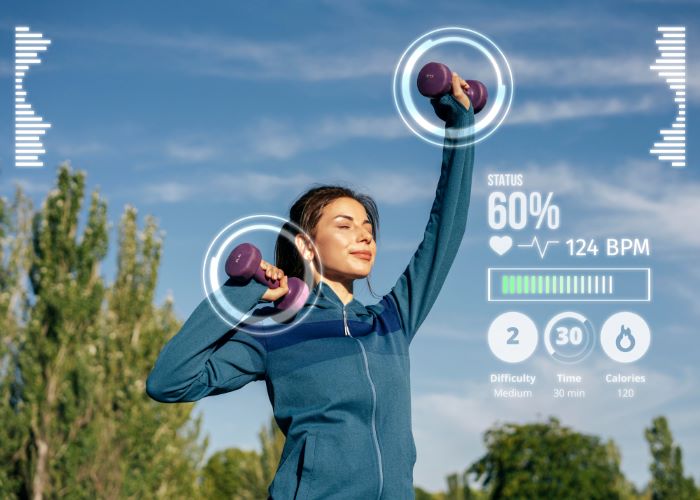In the digital era, where fitness apps have become integral to our pursuit of a healthier lifestyle, the importance of user-centric design cannot be overstated. Successful fitness apps not only offer effective workouts and tracking features but also ensure that users can navigate their interfaces with ease and satisfaction. This seamless experience is largely driven by graphic design, which encompasses the visual elements, layouts, and interactions that guide users through the app. In this comprehensive exploration, we delve into how fitness apps prioritize graphic design to create intuitive navigation, enhancing user engagement and overall effectiveness.
The Significance of User-Centric Design
Meeting User Expectations
User-centric design revolves around understanding and meeting the expectations of the app’s target audience. In the context of fitness apps, this means recognizing that users seek simplicity, clarity, and convenience in their fitness journey. Visual elements play a pivotal role in fulfilling these expectations.
Enhancing User Experience
An app’s success hinges on the overall user experience it provides. A well-designed interface that prioritizes intuitive navigation can significantly enhance the user experience. It reduces friction, minimizes frustration, and encourages users to engage with the app regularly, ultimately leading to better results.
The Fundamental Principles of User-Centric Graphic Design
Visual Hierarchy
Visual hierarchy refers to the arrangement and prioritization of elements within an interface. In fitness apps, this principle dictates that essential elements, such as workout options or tracking features, should be prominent and easily accessible. Designers use techniques like size, color, and contrast to establish a clear visual hierarchy.
Consistency
Consistency in design is essential for creating a predictable and user-friendly experience. Fitness apps maintain consistency in various aspects, including button placement, typography, and the use of icons. When users encounter familiar design elements across the app, they can navigate confidently.
Simplicity
Simplicity is at the heart of user-centric design. Overly complex interfaces can overwhelm users and deter them from using the app regularly. Fitness apps prioritize simplicity by eliminating unnecessary clutter and providing straightforward navigation pathways.
The Role of Visual Elements in User-Centric Design
Intuitive Icons
Icons are a fundamental component of user-centric design. In fitness apps, icons represent various functions, such as workouts, settings, and progress tracking. To ensure intuitiveness, icons should be universally recognized symbols and visually distinct to avoid any confusion.
Readable Typography
Typography plays a significant role in ensuring the readability of app content. Fitness apps use legible fonts and appropriate font sizes to make text easily readable on various screen sizes. Proper spacing and line height also contribute to a comfortable reading experience.
High-Quality Imagery
High-quality imagery, including exercise illustrations and progress charts, is essential for user engagement. These visuals not only convey information effectively but also inspire and motivate users. Crisp, clear images contribute to a positive user experience.
Color Psychology
Color choices in fitness apps can influence user behavior and mood. For example, calming blues and greens may be used in meditation or relaxation features, while energetic reds and oranges may be employed in high-intensity workout sections. Color psychology is a powerful tool for enhancing the user experience.
The Mobile-Friendly Approach
Responsive Design
With the majority of users accessing fitness apps on mobile devices, a mobile-friendly approach is crucial. User-centric design ensures that app layouts adapt seamlessly to various screen sizes and orientations. Responsive design principles ensure a consistent and enjoyable experience on smartphones and tablets.
Gesture-Based Navigation
Gesture-based navigation is a user-centric design feature that caters to mobile users. Swiping, tapping, and pinching gestures provide an intuitive way to interact with the app. Properly implemented, these gestures enhance navigation and user satisfaction.
Real-World Examples of User-Centric Fitness Apps
Peloton
Peloton, known for its interactive fitness classes, prioritizes user-centric design in its app. The interface offers a clear visual hierarchy, with essential elements like live classes and recent workouts prominently displayed. High-quality imagery and video content engage users, making the app an integral part of their fitness routines.
Fitbit
Fitbit’s app excels in user-centric design by providing a clean and intuitive interface. It emphasizes simplicity, with easy-to-read typography and recognizable icons. The app also uses color psychology effectively, employing calming blues for sleep tracking and energetic reds for exercise sections.
MyFitnessPal
MyFitnessPal’s user-centric design focuses on convenience and accessibility. It offers a straightforward food diary, barcode scanner, and a vast database of foods for tracking nutrition. The app’s consistent layout and typography ensure users can effortlessly log their meals and stay on top of their health goals.
The Design Process: From Concept to Implementation
User Research
User-centric design begins with in-depth user research. Designers seek to understand user needs, preferences, pain points, and motivations. This research informs the design decisions that follow.
Wireframing and Prototyping
Wireframing involves creating a basic layout of the app’s interface, outlining the placement of elements. Prototyping allows designers to test the app’s functionality and navigation before full development begins.
Iterative Design
Iterative design involves continually refining and improving the app’s interface based on user feedback and testing. It’s a cyclical process that ensures the final design aligns with user expectations.
User Testing
User testing involves gathering feedback from real users to identify any usability issues. This feedback guides design adjustments and refinements.
Implementation
Once the design is finalized, it is implemented into the app’s development process. Developers work closely with designers to ensure that the design is faithfully translated into a functional interface.
Future Trends in User-Centric Design for Fitness Apps
Personalization
Personalization is an emerging trend in user-centric design. Fitness apps are increasingly tailoring their interfaces to individual user preferences, offering customized workouts and recommendations based on user data.
Augmented Reality (AR)
AR features are making their way into fitness apps, providing users with interactive and immersive experiences. AR can guide users through workouts or gamify their fitness routines, enhancing engagement.
Accessibility
Accessibility is gaining prominence in user-centric design. Ensuring that fitness apps are accessible to users with disabilities through features like voice commands and screen readers is becoming a priority.
Conclusion: The Impact of Intuitive Navigation
In the world of fitness apps, user-centric design is not a luxury but a necessity. Intuitive navigation driven by thoughtful graphic design is the linchpin that ensures users can seamlessly access the workouts, tracking, and information they need to lead healthier lives. As fitness app developers continue to prioritize user-centric graphic design principles and adapt to evolving trends, users can look forward to more engaging, efficient, and enjoyable fitness journeys through their mobile devices. The future of fitness apps is undeniably user-centric, where design is a silent but powerful partner in the pursuit of wellness and vitality.

